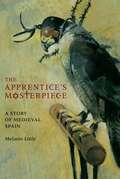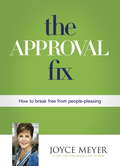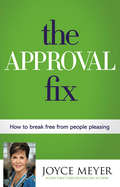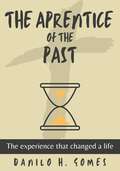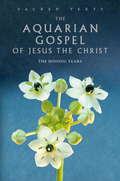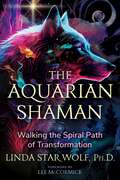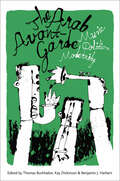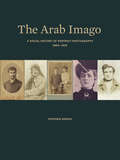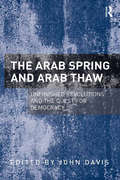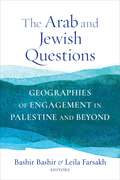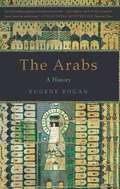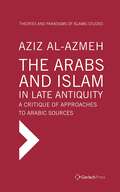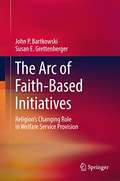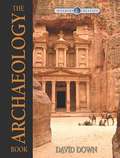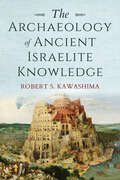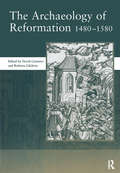- Table View
- List View
The Apprentice's Masterpiece: A Story of Medieval Spain
by Melanie LittleFifteenth-century Spain had a society in which Jews, Muslims and Christians coexisted. But under the zealous Christian Queen Isabella, the country abruptly became one of the most murderously intolerant places on Earth.
The Appropriation of Religion in Southeast Asia and Beyond
by Michel PicardThis volume investigates various processes by which world religions become localized, as well as how local traditions in Southeast Asia and Melanesia become universalized. In the name of modernity and progress, the contemporary Southeast Asian states tend to press their populations to have a 'religion,' claiming that their local, indigenous practices and traditions do not constitute religion. Authors analyze this 'religionization,' addressing how local people appropriate religion as a category to define some of their practices as differentiated from others, whether they want to have a religion or are constrained to demonstrate that they profess one. Thus, 'religion' is what is regarded as such by these local actors, which might not correspond to what counts as religion for the observer. Furthermore, local actors do not always concur regarding what their religion is about, as religion is a contested issue. In consequence, each of the case studies in this volume purposes to elucidate what gets identified and legitimized as 'religion', by whom, for what purpose, and under what political conditions.
The Approval Fix: How to Break Free From People-Pleasing
by Joyce MeyerWhen we hear the word addiction, we tend to think of unbreakable habits involving drugs or alcohol. But many people struggle each day with a different kind of addiction: a deep need for the approval of others. Their unquenchable thirst for love and acceptance often causes people to suffer in relationships, give up on their dreams, and even forfeit their destinies. The key to breaking free from approval addiction, and the people-pleasing that goes along with it, is to understand and embrace the love of God and others and to be able to love yourself.In The Approval Fix, best-selling author Joyce Meyer offers the practical insights and lessons necessary to find freedom from the need for approval. Anyone who wants to enjoy life and build healthy relationships, but struggles to feel accepted, will benefit immensely from this book, which is full of proven principles from Meyer's years of experience helping people find freedom in many areas of their lives.
The Approval Fix: How to Break Free from People Pleasing
by Joyce MeyerEverybody wants to be loved. We all need affirmation, acceptance, and approval. Let's face it: It feels good to be appreciated and admired. But when we depend on the approval of others to feel good about ourselves, it's impossible to have emotional stability or a healthy self-image. And when our value is based on how people see us rather than God's unconditional love for us, our desire for approval can become an addiction. In THE APPROVAL FIX, #1 New York Times bestselling author Joyce Meyer gives you practical insights that will help you learn how to accept who you are and become the unique individual God created you to be. You'll experience greater confidence, deeper emotional stability, and healthier relationships-the life you're really longing for. Today, discover the truth about God's love for you and approval of you. And enjoy the freedom to be the amazing person you can be in Him! Derived from material previously published in Approval Addiction.
The Aprentice of the past: The experience that changed a life
by Danilo H. GomesOne single experience rich in meaning was enough for Douglas to have his life transformed forever. So much is said about time travel and fixing past mistakes, but what if we could just interact with other lives instead of our own? Douglas won this strange opportunity and became involved in conversations that he never imagined having. Get to know the experience that this young man had and, who knows, have his life transformed too.
The Apricot Memoirs
by Tess GuineryWhat started as a break from Australian artist Tess Guinery&’s rapidly growing design business turned into an instinctive, playful experiment with words, colors, and sounds—and eventually into a tangible book, The Apricot Memoirs.This collection of poetry and prose, thoughtfully illustrated and printed on colored paper, is infused with grace and playfulness. It explores love, personal growth, creativity, spirituality, vulnerability, and motherhood in the art medium of words, all the while creating a rich portrait of a deeply empathetic, talented, and whimsical artist. Esoteric, mysterious, and unfailingly beautiful, The Apricot Memoirs is an invitation to dig deep, embrace the uncomfortable, and free your creativity, unbound.
The Apse Mosaic in Early Medieval Rome: Time, Network, and Repetition.
by Thunø. ErikThis book focuses on apse mosaics in Rome, which were commissioned by a series of popes between the sixth and ninth centuries CE. Through a synchronic approach that challenges current conceptions about how works of art interact with historical time, Erik Thunø proposes that the apse mosaics produce an inter-visual network that collapses their chronological succession in time into a continuous present in which the faithful join the saints in the one living body of the Church of Rome. Throughout, this book situates the apse mosaics within the broader context of viewership, the cult of relics, epigraphic tradition, and church ritual while engaging topics concerned with intercession, materiality, repetition and vision.
The Aquarian Gospel of Jesus the Christ
by Alan Jacobs Levi H. DowlingWhat happened to Jesus between the ages of 12 and 30? Where did he go, whom did he meet? How did Jesus increase 'in wisdom and stature, and in favour with God and man'? The Aquarian Gospel reveals the truth of Jesus' journey to the East and how this shaped the boy into the man.
The Aquarian Gospel of Jesus the Christ
by LeviThe Philosophic and Practical Basis of the Religion of the Aquarian Age of the World and of the Church Universal, Transcribed from the Book of God's Remembrances, Known as the Akashic Records, by Levi, with Introduction by Eva S. Dowling. CONTENTS: Birth and Early Life of Mary, Mother of Jesus--Birth and Infancy of John the Harbinger, and of Jesus--Education of Mary and Elizabeth in Zoan--Childhood and Early Education of John the Harbinger--Childhood and Early Education of Jesus--Life and Works of Jesus in India--Life and Works of Jesus in Tibet and Western India--Life and Works of Jesus in Persia--Life and Works of Jesus in Assyria--Life and Works of Jesus in Greece--Life and Works of Jesus in Egypt--The Council of the Seven Sages of the World--The Ministry of John the Harbinger--The Christine Ministry of Jesus--The Betrayal and Arrest of Jesus--The Trial and Execution of Jesus--The Resurrection of Jesus--Materialization of the Spiritual Body of Jesus--Establishment of the Christine Church.
The Aquarian Gospel of Jesus the Christ
by Levi DowlingThis visionary text professes to tell the complete story of Jesus' life, including the "lost" years, during which he traveled and studied in Tibet, Egypt, India, Persia, and Greece. First published in 1908, this mystical work is the cornerstone of a Christian denomination, the Aquarian Christine Church Universal, and it offers intriguing, controversial assertions about Christ's message.Jesus was conceived by a human father, author Levi Dowling states, and by effort and prayer rendered himself a fit vessel for "the Christ" -- the model for human existence and ultimate salvation. Dowling, who devoted forty years of preparation to the task of transcribing this volume's contents from original Akashic records, further asserts the reality of reincarnation and its culmination in the perfection of the human soul. Tracing Jesus' life from his birth in Bethlehem to his ascension from the Mount of Olives, Dowling offers complete details concerning the savior's years among monks, wise men, and seers throughout the Orient. Readers with an interest in occult lore and the history of religion will find this remarkable volume a source of endless fascination.
The Aquarian Gospel of Jesus the Christ
by Levi H. DowlingActually published in 1908, Dowling asserted that he had transcribed this work from Akashic records, which gave a detailed account of the life of Jesus. The title was derived from an age determined by constellations, adding an astrological meaning with an appellation that indicated the Age of Aquarius. The Aquarian Gospel has been deemed an apocryphal work, despite the fact that it was written and published recently, noticeably later than most other works of the same nature. It does have in common with such writings an account of the entire life of Jesus in 182 chapters, beginning with the early life of his mother Mary and going through his death and Resurrection, concluding with Pentecost and the foundation of the Christian Church. Though controversial and considered to contain inaccuracies, Dowling's work does make claims of a comforting nature, such as the assertion that 'No soul is ever abandoned by God. ' with that and other reassuring claims, the Aquarian Gospel has tentatively taken its place amid other works of religious literature.
The Aquarian Shaman: Walking the Spiral Path of Transformation
by Linda Star Wolf• Shares shamanic practices, rituals, ceremonies, and wisdom to help you reintroduce magic into everyday life and awaken the Aquarian Shaman within• Explains major components of shamanic practice, including totem animals, spirit teachers, personal altars, medicine wheels, the power of song and dance, and the use of sacred objects and sacred circles• Explores the shamanic realm of imagination and techniques to access it, including Shamanic Breathwork and spirit journeyingAre you hearing a persistent inner calling to wake up and remember who you really are? Are you ready to be reborn into shamanic consciousness and awaken as an elemental being, fully connected to life and nature?Presenting a guidebook to walking the spiral path of transformation, shamanic teacher Linda Star Wolf shares ancient shamanic practices, rituals, ceremonies, and wisdom to help you reintroduce magic and enchantment into everyday life, create your own &“shamanic medicine chest,&” and awaken the Aquarian Shaman within.Describing how to recover the magical sensibility and innate awareness that most of us leave behind in childhood, Star Wolf shares essential shamanic techniques, including the Shamanic Healing Initiatory Process and Shamanic Breathwork. She discusses the power of the imagination, showing how imagination is actually a liminal realm rooted in the cellular records of our body through which we can journey to other worlds and connect with our ancestors.This Aquarian guidebook will help you not only awaken to shamanic consciousness but also cultivate more love, inner awareness, and personal power as you walk the spiral path of transformation.
The Arab Avant-Garde: Music, Politics, Modernity (Music Culture)
by Thomas Burkhalter, Kay Dickinson, and Benjamin J. HarbertThe first in-depth study of diverse and radical innovation in Arab music From jazz trumpeters drawing on the noises of warfare in Beirut to female heavy metallers in Alexandria, the Arab culture offers a wealth of exciting, challenging, and diverse musics. The essays in this collection investigate the plethora of compositional and improvisational techniques, performance styles, political motivations, professional trainings, and inter-continental collaborations that claim the mantle of "innovation" within Arab and Arab diaspora music. While most books on Middle Eastern music-making focus on notions of tradition and regionally specific genres, The Arab Avant Garde presents a radically hybrid and globally dialectic set of practices. Engaging the "avant-garde"—a term with Eurocentric resonances—this anthology disturbs that presumed exclusivity, drawing on and challenging a growing body of literature about alternative modernities. Chapters delve into genres and modes as diverse as jazz, musical theatre, improvisation, hip hop, and heavy metal as performed in countries like Iraq, Egypt, Lebanon, Syria, Palestine, and the United States. Focusing on multiple ways in which the "Arab avant-garde" becomes manifest, this anthology brings together international writers with eclectic disciplinary trainings—practicing musicians, area studies specialists, ethnomusicologists, and scholars of popular culture and media. Contributors include Sami W. Asmar, Michael Khoury, Saed Muhssin, Marina Peterson, Kamran Rastegar, Caroline Rooney, and Shayna Silverstein, as well as the editors.
The Arab Imago: A Social History of Portrait Photography, 1860–1910
by Stephen SheehiThe first history of indigenous photography in the Middle EastThe birth of photography coincided with the expansion of European imperialism in the Middle East, and some of the medium's earliest images are Orientalist pictures taken by Europeans in such places as Cairo and Jerusalem—photographs that have long shaped and distorted the Western visual imagination of the region. But the Middle East had many of its own photographers, collectors, and patrons. In this book, Stephen Sheehi presents a groundbreaking new account of early photography in the Arab world.The Arab Imago concentrates primarily on studio portraits by Arab and Armenian photographers in the late Ottoman Empire. Examining previously known studios such as Abdullah Frères, Pascal Sébah, Garabed Krikorian, and Khalil Raad, the book also provides the first account of other pioneers such as Georges and Louis Saboungi, the Kova Brothers, Muhammad Sadiq Bey, and Ibrahim Rif'at Pasha—as well as the first detailed look at early photographs of the annual pilgrimage to Mecca. In addition, the book explores indigenous photography manuals and albums, newspapers, scientific journals, and fiction.Featuring extensive previously unpublished images, The Arab Imago shows how native photography played an essential role in the creation of modern Arab societies in Egypt, Palestine, Syria, and Lebanon before the First World War. At the same time, the book overturns Eurocentric and Orientalist understandings of indigenous photography and challenges previous histories of the medium.
The Arab Spring and Arab Thaw: Unfinished Revolutions and the Quest for Democracy
by John DavisWhat were the unifying principles or strategies that governed the protest movements that swept the Middle East and North Africa in the spring of 2011? Who were the protestors and how did the different authoritarian regimes respond to them? How did regional and international institutions react to a region in turmoil? The Arab Spring and Arab Thaw; Unfinished Revolutions and the Quest for Democracy addresses these questions by examining a range of successful and unsuccessful protest strategies and counter revolutionary tactics employed by protestors and autocratic regimes. Contributors explore the reactions of the USA, EU and Arab League to events in the region and provide insight as to the gendered dimensions of the struggle along with the ethnic and tribal divisions that continue to impact the post-revolt period. By addressing these critical queries the book demonstrate how the Arab Spring has evolved into a protracted Arab Thaw that continues to profoundly affect regional and international politics.
The Arab Winter: A Tragedy
by Noah FeldmanWhy the conventional wisdom about the Arab Spring is wrongThe Arab Spring promised to end dictatorship and bring self-government to people across the Middle East. Yet everywhere except Tunisia it led to either renewed dictatorship, civil war, extremist terror, or all three. In The Arab Winter, Noah Feldman argues that the Arab Spring was nevertheless not an unmitigated failure, much less an inevitable one. Rather, it was a noble, tragic series of events in which, for the first time in recent Middle Eastern history, Arabic-speaking peoples took free, collective political action as they sought to achieve self-determination.Focusing on the Egyptian revolution and counterrevolution, the Syrian civil war, the rise and fall of ISIS in Syria and Iraq, and the Tunisian struggle toward Islamic constitutionalism, Feldman provides an original account of the political consequences of the Arab Spring, including the reaffirmation of pan-Arab identity, the devastation of Arab nationalisms, and the death of political Islam with the collapse of ISIS. He also challenges commentators who say that the Arab Spring was never truly transformative, that Arab popular self-determination was a mirage, and even that Arabs or Muslims are less capable of democracy than other peoples.Above all, The Arab Winter shows that we must not let the tragic outcome of the Arab Spring disguise its inherent human worth. People whose political lives had been determined from the outside tried, and for a time succeeded, in making politics for themselves. That this did not result in constitutional democracy or a better life for most of those affected doesn't mean the effort didn't matter. To the contrary, it matters for history—and it matters for the future.
The Arab and Jewish Questions: Geographies of Engagement in Palestine and Beyond (Religion, Culture, and Public Life #39)
by Bashir Bashir Leila FarsakhNineteenth-century Europe turned the political status of its Jewish communities into the “Jewish Question,” as both Christianity and rising forms of nationalism viewed Jews as the ultimate other. With the onset of Zionism, this “question” migrated to Palestine and intensified under British colonial rule and in the aftermath of the Holocaust. Zionism’s attempt to solve the “Jewish Question” created what came to be known as the “Arab Question,” which concerned the presence and rights of the Arab population in Palestine. For the most part, however, Jewish settlers denied or dismissed the question they created, to the detriment of both Arabs and Jews in Palestine and elsewhere.This book brings together leading scholars to consider how these two questions are entangled historically and in the present day. It offers critical analyses of Arab engagements with the question of Jewish rights alongside Zionist and non-Zionist Jewish considerations of Palestinian identity and political rights. Together, the essays show that the Arab and Jewish questions, and the Israeli-Palestinian conflict in which they have become subsumed, belong to the same thorny history. Despite their major differences, the historical Jewish and Arab questions are about the political rights of oppressed groups and their inclusion within exclusionary political communities—a question that continues to foment tensions in the Middle East, Europe, and the United States. Shedding new light on the intricate relationships among Orientalism, anti-Semitism, Islamophobia, colonialism, and the impasse in the Israeli-Palestinian conflict, this book reveals the inseparability of Arab and Jewish struggles for self-determination and political equality.Contributors include Gil Anidjar, Brian Klug, Amal Ghazal, Ella Shohat, Hakem Al-Rustom, Hillel Cohen, Yuval Evri, Derek Penslar, Jacqueline Rose, Moshe Behar, Maram Masarwi, and the editors, Bashir Bashir and Leila Farsakh.
The Arabic Historical Tradition & the Early Islamic Conquests: Folklore, Tribal Lore, Holy War
by Boaz ShoshanThe early Arab conquests pose a considerable challenge to modern-day historians. The earliest historical written tradition emerges only after the second half of the eighth century- over one hundred years removed from the events it contends to describe, and was undoubtedly influenced by the motives and interpretations of its authors. Indeed, when speaking or writing about the past, fact was not the only, nor even the prime, concern of Muslims of old. The Arabic Historic Tradition and the Early Islamic Conquests presents a thorough examination of Arabic narratives on the early Islamic conquests. It uncovers the influence of contemporary ideology, examining recurring fictive motifs and evaluating the reasons behind their use. Folklore and tribal traditions are evident throughout the narratives, which aimed to promote individual, tribal and regional fame through describing military prowess in the battles for the spread of Islam. Common tropes are encountered across the materials, which all serve a central theme; the moral superiority of the Muslims, which destined them to victory in God’s plan. Offering a key to the state of mind and agenda of early Muslim writers, this critical reading of Arabic texts would be of great interest to students and scholars of early Arabic History and Literature, as well as a general resource for Middle Eastern History.
The Arabs
by Eugene RoganTo American observers, the Arab world often seems little more than a distant battleground characterized by religious zealotry and political chaos. Years of tone-deaf US policies have left the region powerless to control its own destiny-playing into a longstanding sense of shame and impotence for a once-mighty people. In this definitive account, preeminent historian Eugene Rogan traces five centuries of Arab history, from the Ottoman conquests through the British and French colonial periods and up to the present age of unipolar American hegemony. The Arab world is now more acutely aware than ever of its own vulnerability, and this sense of subjection carries with it vast geopolitical consequences. Drawing from Arab sources little known to Western readers, Rogan’sThe Arabswill transform our understanding of the past, present, and future of one of the world’s most tumultuous regions.
The Arabs and Islam in Late Antiquity: A Critique of Approaches to Arabic Sources (Theories and Paradigms of Islamic Studies)
by Aziz Al-AzmehThis study is a critique of Arabic textual sources for the history of the Arabs in late antique times, during the centuries immediately preceding Muhammad and up to and including the Umayyad period. Its purpose is to consider the value and relevance of these sources for the reconstruction of the social, political, cultural and religious history of the Arabs as they were still pagans, and to reconstruct the emergence of Muhammadan and immediately post-Muhammadan religion and polity. For this religion (including the composition and canonisation of the Qur'an), the label Paleo-Islam has been coined, in order to lend historical specificity to this particular period, distinguishing it from what came before and what was to come later, all the while indicating continuities that do not, in themselves, belie the specificity attributed to this period of very rapid change. This is argued further in Aziz Al-Azmeh's The Emergence of Islam in Late Antiquity: Allah and His People (Cambridge University Press, 2014), to which this book is both a companion and a technical preface. Al-Azmeh illustrates his arguments through examination of orality and literacy, transmission, ancient Arabic poetry, the corpus of Arab heroic lore (ayyam), the early narrative, the Qur'an, and other literary sources. The work includes a very extensive bibliography of the works cited. This is the first book in the Gerlach Press series Theories and Paradigms of Islamic Studies.
The Arc of Faith-Based Initiatives: Religion's Changing Role In Welfare Service Provision
by John P. Bartkowski Susan E. GrettenbergerAnalyzes the activities of faith-based organizations in Mississippi, Michigan, and the Pacific Northwest.<p><p> Compares services delivered by faith-based organizations and secular agencies.<p> Examines family support, transitional homeless, and addiction recovery programs.<p> Offers an in-depth analysis of the topic with rich qualitative data.<p>This volume offers an in-depth examination of a diverse range of faith-based programs implemented in three different geographical locales: family support in rural Mississippi, transitional housing in Michigan, and addiction recovery in the Pacific Northwest (Washington-Oregon). Various types of religious service providers—faith-intensive and faith-related—are carefully examined, and secular organizations also serve as an illuminating point of comparison. Among other insights, this book reveals how the “three C’s” of social service provision—programmatic content, organizational culture, and ecological context—all combine to shape the delivery of welfare services in the nonprofit world. This book warns against simplistic generalizations about faith-based organizations. Faith-based providers exhibit considerable diversity and, quite often, remarkable resilience in the face of challenging social circumstances. An appreciation of these nuances is critical as policies concerning faith-based organizations continue to evolve.
The Arcana of Freemasonry: A History of Masonic Signs and Symbols
by Albert ChurchwardIn this illustrated volume, an expert in arcane symbolism traces Masonic history from Ancient Egypt to the twentieth century through more than one hundred symbols.The Freemasons have profoundly altered the course of history. Their belief in liberty and equality influenced both the French and American Revolutions, as evidenced in part by the symbols on our currency. In The Arcana of Freemasonry, first published in 1915, Albert Churchward weaves a tale of Masonry’s origins in ancient Egypt and its continuance through history—all told via Masonic symbols and symbolism.From Egyptian history and Mayan relief work through Greek mathematicians, philosophers, and metaphysicians, Churchward traces the development of the most basic symbols of Freemasonry. He also reveals the hidden symbolism found in the signs and tools of modern Freemasonry and helps readers find hidden meanings in all areas of life from art and architecture to geometry and poetry.
The Archaeology
by David DownDeveloped with three educational levels in mind, The Archaeology Book takes you on an exciting exploration of history and ancient cultures. You'll learn both the techniques of the archaeologist and the accounts of some of the richest discoveries of the Middle East that demonstrate the accuracy and historicity of the Bible.
The Archaeology of Ancient Israelite Knowledge (Biblical Literature)
by Robert S. KawashimaThe Archaeology of Ancient Israelite Knowledge reconstructs in carefully researched detail the worldview of the ancient Israelites writers responsible for the Hebrew Bible. What was the role of God in their lives? How did they see the relationship between God, nature, and themselves? Contrary to prevailing scholarly understanding, Robert Kawashima argues that the ancient Israelites saw God in a radically different way than the peoples around them. God no longer interconnected everything—humans, nature—but became seen as sharply separated from nature.Elegantly written and powerfully argued, The Archaeology of Ancient Israelite Knowledge is essential reading for anyone wanting to grasp the Hebrew Bible and the ancient world that gave rise to it.
The Archaeology of Reformation,1480-1580 (The\society For Post-medieval Archaeology Monographs)
by David GaimsterTraditionally the Reformation has been viewed as responsible for the rupture of the medieval order and the foundation of modern society. Recently historians have challenged the stereotypical model of cataclysm, and demonstrated that the religion of Tudor England was full of both continuities and adaptations of traditional liturgy, ritual and devoti
